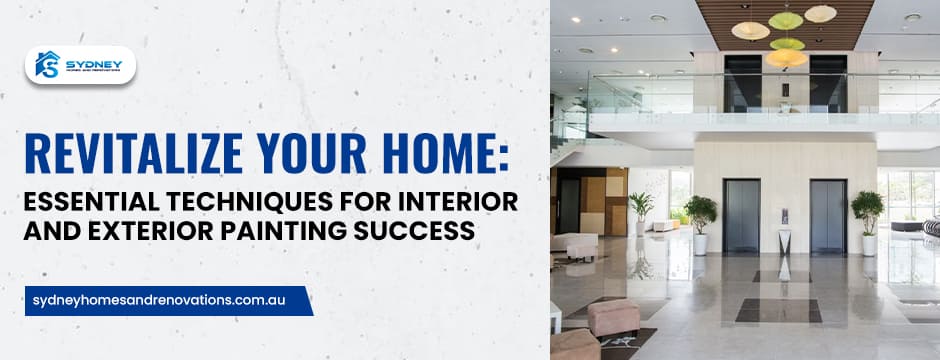Revitalize Your Home: Essential Techniques for Interior and Exterior Painting Success
A fresh coat of paint can completely transform the look and feel of your home, both inside and out. Whether you’re aiming to boost curb appeal or refresh a tired interior, Interior And Exterior Painting is a crucial step in any home renovation project. With the right techniques and a keen eye for detail, painting can revitalize your space, making it feel fresh, modern, and welcoming.
At Sydney Homes And Renovations, we specialize in delivering high-quality painting services that not only enhance the aesthetic of your home but also protect its surfaces. This blog will explore essential techniques for successful Interior And Exterior Painting to help you achieve professional results, whether you’re a DIY enthusiast or planning to hire experts.
1. Preparing for Success: The Foundation of Great Painting
Before you even pick up a paintbrush, preparation is key to achieving a flawless finish. Proper preparation can make or break the outcome of any Interior And Exterior Painting project, and it starts with assessing the surface.
A. Interior Painting Prep: Clean, Smooth, and Prime
- Surface Cleaning: Begin by thoroughly cleaning the walls. Dust, dirt, and grease can prevent paint from adhering properly. A mild detergent or sugar soap solution works well for cleaning interior surfaces.
- Repairing Imperfections: Inspect walls for cracks, dents, or holes and fill them with spackle or a similar filler. Sand the surface smooth once the filler is dry to ensure an even painting surface.
- Priming the Walls: Applying a primer is a crucial step, especially when painting over dark colors or covering stains. Primer helps the new paint adhere better and ensures a uniform finish.
B. Exterior Painting Prep: Weatherproofing and Surface Care
- Surface Inspection: For exterior painting, start by inspecting the surface for signs of damage. Cracks, mold, or peeling paint should be addressed before proceeding.
- Pressure Washing: Cleaning exterior walls is essential to remove grime, mildew, and loose paint. A pressure washer can quickly clean large areas, making the job easier and ensuring the new paint sticks well.
- Repair and Caulking: Repair any damaged areas and use caulk to seal gaps around windows, doors, and trim to prevent moisture from seeping in.
- Priming Exterior Surfaces: Like interior surfaces, exterior walls also benefit from a coat of primer, especially if the surface is porous or you’re making a significant color change.
2. Choosing the Right Paint and Tools
The success of your painting project depends largely on the quality of the paint and tools you choose. Selecting the appropriate type of paint for both interior and exterior surfaces ensures longevity, durability, and aesthetic appeal.
A. Interior Paint Options: Sheen and Durability
- Matte or Flat Finish: Ideal for low-traffic areas like bedrooms and living rooms, this finish hides imperfections well but is less durable and harder to clean.
- Eggshell or Satin Finish: Best for areas like hallways, kitchens, and bathrooms, eggshell and satin finishes offer a subtle sheen that is more durable and easy to clean.
- Semi-Gloss and Gloss Finishes: These are perfect for high-traffic areas or trim and doors. They are highly durable, reflective, and easy to wipe down.
B. Exterior Paint Considerations: Weather Resistance
- Acrylic Latex Paint: The most popular choice for exterior painting, acrylic latex paint is durable, flexible, and resistant to weather conditions, making it perfect for withstanding sun, rain, and fluctuating temperatures.
- Oil-Based Paint: Oil-based paints provide a smooth finish and are highly durable, but they take longer to dry and can be more challenging to work with. However, they are excellent for metal or wood surfaces.
- Weather-Proof Coatings: For exterior projects, consider paints that offer UV protection and are mold and mildew-resistant. This will extend the life of your paint job, especially in Sydney’s variable climate.
C. Selecting the Right Tools
- Brushes and Rollers: Use synthetic-bristle brushes for water-based paints and natural-bristle brushes for oil-based paints. Rollers with different nap lengths should be selected based on the texture of your surface.
- Paint Sprayers: For large exterior surfaces, a paint sprayer can speed up the job and ensure even coverage. However, they require practice and careful masking to avoid overspray.

3. Techniques for Professional-Level Interior Painting
Painting indoors may seem straightforward, but achieving a smooth, even finish requires proper technique. Here are some tips to help you master the art of interior painting.
A. Cutting In
“Cutting in” refers to the process of painting around the edges of walls, such as around trim, ceilings, and corners, before rolling the rest of the surface. Use a high-quality angled brush for precision and take your time to ensure clean lines.
B. The W Technique
When using a roller, the best method for achieving even coverage is the “W technique.” Start by loading your roller with paint and make a “W” shape on the wall. Then fill in the gaps by rolling over the area. This prevents streaks and ensures a smooth finish.
C. Work in Sections
When painting larger areas, work in small sections, maintaining a wet edge to avoid lap marks. Blend each section into the next by rolling in various directions to ensure even coverage.
D. Two Coats Are Better Than One
For the best results, always apply two coats of paint, even if you’re tempted to stop at one. This ensures consistent coverage and a vibrant finish that will last.
4. Mastering Exterior Painting Techniques
Interior And Exterior Painting comes with its own set of challenges, including exposure to the elements. Proper technique is essential to ensure a long-lasting, professional finish.
A. Painting from Top to Bottom
Always start painting at the top of your exterior surface and work your way down. This method helps control drips and ensures smooth, even coverage as you progress.
B. Pay Attention to the Weather
Plan your exterior painting around the weather. Avoid painting in direct sunlight, as this can cause the paint to dry too quickly, leading to cracks and uneven coverage. Ideally, paint on an overcast day or in the early morning to achieve the best results.
C. Mind the Corners and Trim
When painting exterior corners and trim, use a smaller brush to ensure crisp, clean edges. Be sure to apply at least two coats for durability and protection against the elements.
D. Seal the Surface
Once your paint job is complete, consider applying a clear sealant or waterproof coating to help protect the paint from moisture, UV rays, and other environmental factors. This can significantly extend the life of your exterior paint job.
5. Finishing Touches: Clean-Up and Maintenance
Once you’ve finished painting, proper clean-up and maintenance will ensure that your paint job looks great for years to come.
- Clean Your Tools: Rinse brushes, rollers, and trays thoroughly after use to prolong their lifespan. If you’re using oil-based paint, you’ll need a solvent like mineral spirits for cleaning.
- Touch-Up as Needed: Keep some leftover paint for future touch-ups. Over time, scuffs or chips may occur, and having the original paint on hand will help you maintain a flawless finish.
- Exterior Maintenance: For exterior painting, be proactive with maintenance. Regularly inspect your home’s exterior for signs of peeling or weather damage, and schedule touch-ups when necessary.
Conclusion
Whether you’re updating the interior of your home or giving the exterior a fresh look, Interior And Exterior Painting can significantly enhance your home’s appearance and value. With the right techniques and products, you can achieve professional results that stand the test of time. At Sydney Homes And Renovations, we specialize in high-quality painting services, delivering stunning finishes that transform homes. Contact us today to discuss your next painting project and experience the difference a professional touch can make.

